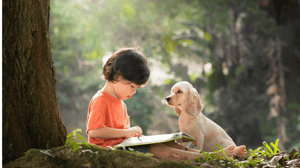What relationship should be fostered between children, nature and animals in postmodern Western societies? How can we create a deep connection to support their development?
The scenarios of the climate crisis raise new questions about the relationship between human beings and the environment. The mass influx of computing devices into our day-to-day lives calls for new educational avenues to support children and responsive parenting. In the future, we will need to cultivate a One Health approach in our children, promoting circular health where humans and the environment are interconnected. And we must also foster empathy and affectivity, so that they can take the world around them into their own hands and transform it, building an ecological identity — as maintained by Bertolino (2017) — that makes them open to the future and passionate about life.
A better quality of life courtesy of nature
The evolutionary biologist Edward Wilson (2002) talks about ‘biophilia’ to describe the deep bond between human beings and nature: the “innate tendency to focus upon life and life-like forms and, in some instances, to affiliate with them emotionally” as a result of an inborn ability. An ability that is not instinctive and must therefore be nurtured, practised and guided along the path of life from an early age.
It has been confirmed by a growing number of studies that teaching people to love and experience nature (Merlchiori, Barzotti 2018) improves their wellbeing and quality of life (Louv 2005, 2011; White et al. 2013; Zelenski, Nisbet 2014). It also fosters a sense of belonging to the world (Wilson 1993; Kaplan 1995), encourages the recovery of awareness and ecological identity (Tomashow 1996; Mortari 2001, 2007; Bardulla 2014) and supports increased focus and concentration (Hertzog et al. 1997; Faber Taylor et al. 2001; Hafner 2002; Kuo, Faber Taylor 2004; Faber Taylor, Kuo 2006, 2009; Stigsdotter et al. 2010, Bowler et al. 2010; Barbiero 2015; Schutte, Torquati, Beattie 2015), not to mention cognitive and emotional development (Waite, Pratt 2011; Sobel 2008; Constable 2012; Sedgwick 2012; Dadvand et al. 2015).
According to the educationalist Richard Louv (2005), over time, the absence of contact with nature leads to ‘nature deficit disorder’ in children. This disorder, not yet altogether clinically recognised, presents with aggressive behaviour, attention and concentration difficulties, forms of depression, and reduced socialisation, with negative repercussions on the development of the capacity for empathy.
Children and animals: learning empathy
To what extent can our children run free and explore in nature? Are they directly acquainted with the forms of life — plants and animals — surrounding them, or do they know them only through digital images and cartoons? How willing are we, as adults, to expand our children’s world view through nature? Do we really think that animals can help them grow and develop?
Dogs are the perfect animal to foster a deep connection with nature. In his scientific narrative description of the origins of dog domestication, the founding father of modern ethology, K. Lorenz (1977), posited that in the Paleolithic Age, when a young girl asked if she could keep a puppy, her father was touched and said yes, she could. Lorenz’s construction of how the humanisation of mankind came about — through the loving heart and hands of a prehistoric child — is intriguing.
What links a prehistoric little girl to present-day little girls and boys? They are bound by a fine ontological and phylogenetic thread, as both are designed to be empathic towards nature and their fellow human beings. According to psychology, empathy is the ability to put oneself in someone else’s shoes, understanding their emotions, feelings and suffering. Scientific evidence shows how the relationship with an animal boosts a person’s self-esteem, making them more conscientiousness, while reducing the risk of isolation (Merlchiori, Barzotti 2018).
One way that we can educate children about the relationship with nature and animals is through animal-assisted interventions (AAIs, or pet therapy), which support and enhance care and healing. Where people are unsuccessful, it is the animal, nature that intervenes, that cures.
It is a method in the making. While there are many descriptive studies on AAIs, standardised studies are few and far between.
Introducing animals as an educational tool is becoming increasingly popular across Europe, including in schools. A standardised study focused on evaluating the impact of introducing animals into schools to help have a positive effect on cognitive development and the development of emotional skills in children. The dog proved to be a perfect moderator in supporting both very agitated and shy children, by adopting different behaviours, encouraging relaxation or stimulating action. In summary, children were found to experience an increase in learning, with improved cognitive development, communication skills, social and interpersonal skills and emotional intelligence. (Merlchiori, Barzotti 2018).
Therapy dogs
Therapy dogs, in particular, are becoming more and more popular in both schools and healthcare settings. Dogs are capable of instinctively understanding and working on children at various levels, right down to the deepest layers of the neurobiological pathways. Wellbeing is enhanced by contact, closeness, non-verbal communication and the relational space created between child and dog in the presence of the pet therapist/adult.
Scientific studies have shown how physical contact with an animal (stroking or brushing) lowers the plasma levels of cortisol (the so-called ‘stress hormone’) in both species. What’s more, interaction with animals, especially dogs, increases the levels of hormones and neurotransmitters that are capable of generating positive emotions, such as endorphins and dopamine, as well as those that stimulate sociability, like oxytocin. The latter is a neuropeptide secreted by the nuclei of the hypothalamus that not only reduces anxiety and stress and improves mood, but also fosters social interactions and connections and builds the sense of trust in others. Researchers have shown how the concentration of oxytocin in the urine of dog owners, measured following positive interactions with their dogs, is favourably correlated with the amount of mutual gazing exchanged between them and their pet (Nagasawa M., Mitsui S., En S., et al. 2015).
One method of intervention on the Italian AAI scene to support children’s development and parenting is the Luckyleo® Method (Teresa Albergo 2018), which combines the benefits of reading aloud with the presence and mediation of a dog/pet, based on a wealth of scientific evidence on the importance of reading aloud in the family from birth. Different emotional and cognitive levels or layers are enhanced by combining reading aloud, using sensory ‘touch and feel’ books, with the presence and mediation of a dog. The relationship of understanding between the child and the animal, established through physical contact as well as through the sensory books, activates and regulates basic emotions and neurophysiological mechanisms. Communication with the animal is based on gestures and actions, and on proxemics and non-verbal communication. The contact mediated by the book and by the animal reaches every inch of the child, giving them a metaphorical hug through the voice of the person reading and leading the session. The dog can serve as a bridge to convey warmth, emotions and lived experiences that relate to the life situation of everyone, regardless of the existential condition of the individual.
Teaching literacy from birth in connection with the dog/pet and nature means opening up new educational and developmental avenues to build a world where we are all compassionate towards everyone and everything, including nature itself.
The prehistoric little girl symbolically steps into the modern-day world through the dog.
By Catterina Seia and Teresa Albergo
Teresa Albergo, psychologist and therapist
Bibliography
[1] Albergo T. (2018) Io leggo con il mio cane [I Read with my Dog], Edizioni Sonda, Milano;
[2] Conference Proceedings 2011 e 2015 edited by Maria Teresa Cairo
Master in Animal-Assisted Educational and Rehabilitative Interventions, Cattolica del Sacro Cuore University, Milan;
[3] Barbiero G. Berto R. (2016) Introduzione alla biofilia. La relazione con la natura tra genetica e psicologia [Introduction to Biophilia. The Relationship with Nature through Genetics and Psychology] Carocci Editore – Dimensione della Psicologia, Roma;
[4]Dale P.S., Simonoff et al., Genetic Influence on language delay in two-year-old children, Nature Neuroscience, n. 1 (4), pp. 324 - 328, Agosto 1998;
[5] National Guidelines on Animal-Assisted Interventions: the Role of the Istituto Superiore di Sanità [Italian Institute of Health];
[6] M. Borgi, A. Berry, S. Cerino, C. Correale, L. Crescimbene, N. Francia, I. Pistella, E. Alleva, F. Cirulli ;
[7] Lorenz K. (1977) E L’uomo incontrò il cane [Man Meets Dog], Adelphi, Milano;
[8] Louv R. (2006) L’ultimo bambino nei boschi. Come ravvicinare i nostri figli alla natura [Last Child in the Woods. How to Bring our Children Closer to Nature], Rizzoli, Milano;
[9] B. Mampe ed al - Newborn’s cry melody is shaped by their native language, Current Biology, n. 19 (23) pp. 1994 - 1997, 15 dicembre 2009 ;
[10] Marchesini R. (2017) The Child-Dog Duo as an Aid to Child Development;
[11] Moschetti A., et al Dalla voce Materna al Cervello del Neonato [From the Mother’s Voice to the Newborn’s Brain], Quaderni acp 2007, Vol. 14, N.4, pag. 188 – 189 ;
[12] Wilson E. (2021) Biofilia il nostro legame con la natura [Biophilia, our Bond with Nature], Edizioni Piano b, Bologna.




